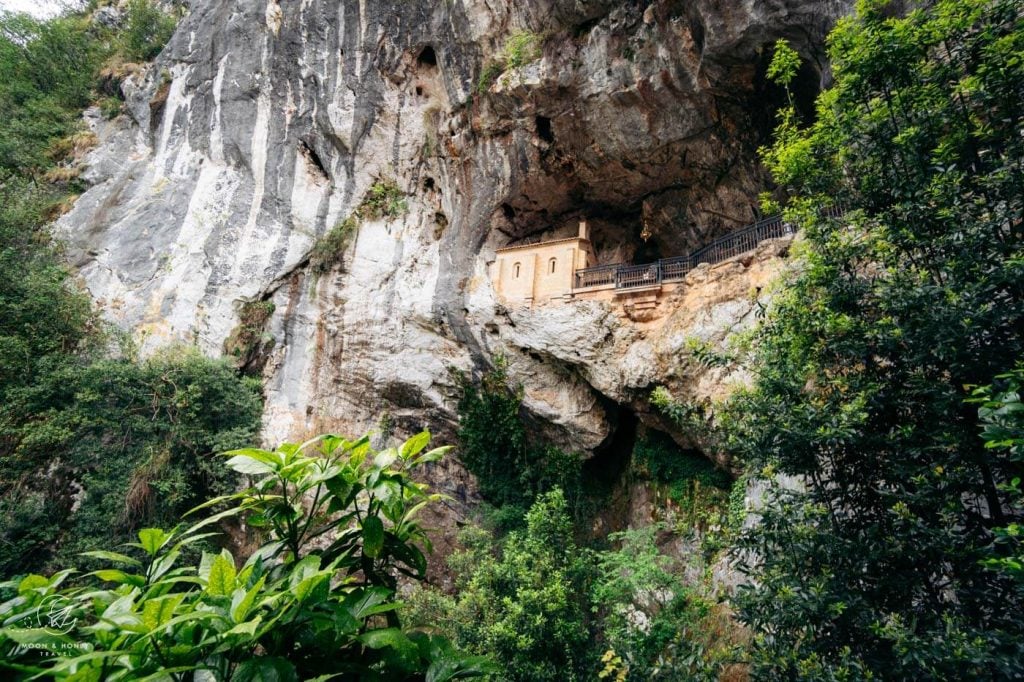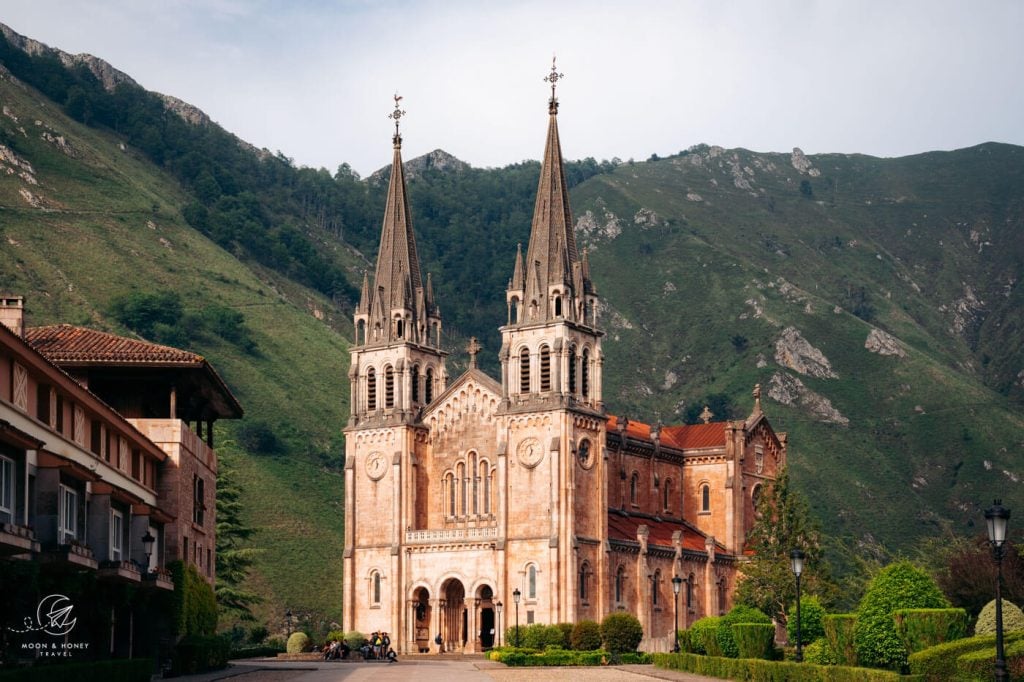The Sanctuary of Covadonga is located in Asturias in Northern Spain. More specifically, it’s situated in Picos de Europa National Park between the town of Cangas de Onís and the Lakes of Covadonga.
The Covadonga Sanctuary is a place of worship and pilgrimage dedicated to Our Lady of Covadonga. It comprises the (1) Holy Cave, (2) Basilica, (3) Covadonga Museum, (4) San Fernando Collegiate Church, and (5) Monument to King Pelayo.
After we visited the Sanctuary and the Lakes of Covadonga, I had so many questions about the history and legends surrounding this historic place. In an effort to piece it all together, I ended up writing this guide.
Kati and I visited the Holy Cave and the Basilica the day before we visited the Lakes of Covadonga. However, it’s common to visit both attractions in a single day. If you’re traveling with a car, drive up to the Covadonga Lakes before 7:30 am. Afterwards, drive back down to Covadonga to visit the Sanctuary.

- Location: Covadonga, Asturias, Spain | Google Maps
- Entrance Fee: None
- Where to Stay in Covadonga: Casa Rural Priena (budget), Hotel El Repelao (budget), Hotel La Casona de Llerices (midrange)
- Where to Stay in Cangas de Onís: Hotel Ecos del Sella (midrange), Apartamentos Prestin (midrange), Hotel Mirador de la Cepada (luxury)
- Recommended Itinerary: 10-Day Picos de Europa Road Trip
Covadonga Map
Covadonga History

Covadonga is a very important historical and religious site in Asturias.
This is where the first battle of the Spanish Reconquest (Reconquista) took place in 718. The Reconquista is the 800-year-long struggle between the Muslims (Moors) and Christians for control of the Iberian Peninsula, which ultimately results in the reinstatement of Christian rule.
In the Battle of Guadalete in 711, the Moors killed the Christian Visigoth King of Spain and then swiftly conquered much of Visigothic Spain. Christians fled to the Cantabrian Mountains, where the Visigoth nobleman Pelayo (aka Pelagius of Asturias) was setting up a resistance.
Under Don Pelayo, the Asturians refused to lay down their arms and surrender to the invading Moors, even though they were severely outnumbered.
During the conflict, Pelayo and his Christian forces retreated to a cave, where a hermit had hidden a statue of the Virgin Mary (Our Lady of Covadonga) in wake of the Muslim conquest.
After praying to the statue for victory, Pelayo and his Christian army defeated the Moors on Mount Auseva in the Battle of Covadonga in 718. Pelayo and his troops attributed the battle’s success to the cave-dwelling Virgin Mary statue.
Afterwards, Pelagius of Asturias consolidated the newly-founded Asturian monarchy and set up his royal court and capital in Cangas de Onis, reigning for 19 years.
For the next 57 years, Cangas de Onis was the seat of the Asturian Kingdom.
To commemorate the Battle of Covadonga and the Virgin Mary’s help, King Alfonso I of Spain instructed that a chapel and monastery be built and dedicated to Our Lady of Covadonga. Once the chapel was built, King Alfonso I moved Pelayo’s remains to the Holy Cave.
Covadonga Sanctuary

The most important places to see in the Covadonga Sanctuary are the Holy Cave (Santa Cueva) and the grandiose pink basilica (Basílica de Santa María la Real de Covadonga).
This is a holy site, so please respect the rules: don’t take photos of the shrine and don’t visit the Basilica during mass, etc…
The Holy Cave Chapel (Santa Cueva)

Covadonga, which comes from the latin phrase Cova Dominica, means the Grotto of Our Lady.
The Holy Cave of Our Lady of Covadonga (Santa Cueva de Nuestra Señora de Covadonga in Spanish) is a sacred Catholic chapel and shrine set in a cave above a waterfall and pool.
It houses the sacred icon of Our Lady of Covadonga (La Santina, the Little Saint), a doll-sized statue garbed in rich robes.
With fresh flowers adorning the altar, it’s not so unlike a religious site in Nepal, or Thailand. It’s believed that the original icon was responsible for helping Pelayo’s forces defeat the invading Moors.
Though of course Catholic today, this cave was likely used for prehistoric pagan worship. Christinas are the greatest and cleverest appropriators of all time, are they not?
The Holy Cave also holds the tomb of King Pelayo (Pelagius of Asturias) and other Asturian royalty.
The cave is easy to locate. You can see the pool and cave from the Carretera Soto de Cangas -Covadonga road (Google Maps).
Walk up the stairway to the cave chapel and then proceed through the cave tunnel to the other end. Walk along the basilica esplanade to the looming Basilica.
There’s no entrance fee to enter.
Basilica

The Basilica of Our Lady of Covadonga (Basílica de Santa María la Real de Covadonga in Spanish) is the most eye-catching structure in the Covadonga Sanctuary. It’s a large church constructed with pink stone. The entrance is flanked with two high towers.
This Neo-Romanesque Church was designed by Roberto Frassinelli and built between 1877 and 1901 by architect Federico Aparici y Soriano.
There’s no entrance fee to enter.
Our Lady of Covadonga Feast Day / Fiesta de la Santina

Listen up, this is wild. So, a replica of the Our Lady of Covadonga statue is located in the depths of Lake Enol, one of the Covadonga Lakes.
Each year, on September 8th, the statue is removed as part of the festivities celebrating the Feast day of Our Lady of Covadonga, the patroness of Asturias.
You can see photos here and a video here. After the festivities, the divers return the statue to its watery depths.
This ritual of submerging and retrieving the statue started in 1972. It was an initiative of the Caña Pescamar fishing club in Gijón. The club created the replica statue with the underwater remains of rifles.

I have SO MANY questions. Why is the statue placed in the water? What’s the symbolic significance of the water? Is Our Lady of Covadonga based on a pagan goddess? What does Lake Enol represent? What’s the link between this lake and the Virgin Mary?
Luckily, I found this delicious story, which is part myth, part fable.
Many years ago, a girl was wandering around the fertile plains of Covadonga during a storm.
She was lost and confused and sought refuge in one of the shepherds’ huts. She walked from hut to hut, asking for shelter. Seeing her condition and state of dress, the shepherds mocked her and turned her away.
Finally, she walked up to the highest and humblest hut of all. The family graciously offered her shelter.
The girl instructed them to gather their cattle and steer them to higher elevation for safety. The family followed her instructions and, sure enough, the entire plain was flooded below the following day. With the exception of their home, all of the other huts were wiped out in the flood.
This is how Lago Enol was formed. And, it’s believed that this young woman was the Virgin of Covadonga.
Though it’s impossible to corroborate this myth, I’d love to know if locals are familiar with this story and whether, or not they associate Lake Enol with this tale of vengeance.
Where to Stay near the Covadonga Sanctuary
Cangas de Onís Accommodations

Where we stayed – Midrange | Hotel Ecos del Sella stands out with its modern, millennial-friendly decor, air-conditioned rooms, and relaxing communal spaces. We loved staying here. The breakfast was phenomenal. The design and concept were refreshing. And, there’s plentiful parking. The only downside is that it’s not within walking distance to Cangas de Onís (3 minute drive to the main car park).
Midrange | Apartamentos Prestin offers spotless 1-2 bedroom air-conditioned apartments with on-site parking. It’s a 7-minute walk to the town center of Cangas de Onís.
Luxury | Hotel Mirador de la Cepada (3 nights minimum stay in high season) is a 4-star hotel that stands on a hill overlooking the Sella River Valley and Cangas de Onís. Rooms are beautifully-furnished, spacious, air-conditioned, and equipped with tea and coffee makers. Free parking is available on site. Definitely book the breakfast. The restaurant and bar are open seasonally.
Look for accommodation in Cangas de Onís.
Covadonga Accommodations
Budget | Casa Rural Priena is a comfortable B&B with a garden, bar, and free parking.
Budget | Hotel El Repelao is a hotel and restaurant in Covadonga, 1.5 km from the Sanctuary. Rooms are clean and decorated in a country-house-style. We ate lunch in their restaurant and it was wonderful. Breakfast is included.
Midrange | Hotel La Casona de Llerices (3 nights minimum stay in high season) is located in Llerices, close to Covadonga. This is a lovely hotel with 11 comfortable and lovingly-furnished rooms. Breakfast is available. Parking is free.
Look for accommodation in Covadonga.
Picos de Europa Trip Planning Essentials
Picos de Europa National Park stretches across three regions in Northern Spain: Asturias, Cantabria, and León (Castile and León).
It comprises the majestic Picos de Europa Mountains, a limestone mountain range composed of three massifs.
How to Get to Picos de Europa
The closest airports to Picos de Europa are Santander Airport in Cantabria, the Asturias Airport (aka Oviedo-Ranón, OVD) in Asturias, and the Bilbao Airport in Basque Country.
We recommend renting a car from the airport and driving directly to Picos de Europa National Park. Follow our 10-day Picos de Europa road trip itinerary for inspiration.
Use the intuitive Discovercars.com car rental reservation platform to search for and book car rentals. This easy-to-use booking platform compares car rental deals from 500+ trusted providers, so that you can choose the best option for your trip.
Where to Stay in Picos de Europa
We recommend dividing your time between Northern Picos de Europa and Eastern Picos de Europa. If you have more time, extend your visit to Southern Picos de Europa and Northwestern Picos de Europa.
Northern Picos de Europa: Poncebos, Arenas de Cabrales (Las Arenas), Sotres, or Tielve in Asturias
Eastern Picos de Europa: Potes, or Camaleño Valley in Cantabria
Southern Picos de Europa: Valdeón Valley, or Caín in León
Northwestern Picos de Europa: Cangas de Onís, Soto de Cangas, Llerices, or Covadonga in Asturias
Find out where to base yourself in the national park in Where to Stay in Picos de Europa.
Hiking in the Picos de Europa National Park
Hiking in Picos de Europa National Park is an extraordinary experience filled with magical landscapes of lush forests, craggy mountains, and deep gorges.
During our road trip, we hiked the Ruta del Cares trail, the El Cable to Fuente Dé trail, Brez to Canal de las Arredondas circuit trail, and the Covadonga Lakes to Vega de Ario trail.
We also hiked this riveting 2-day Refugio Jou de los Cabrones trek.
Picos de Europa Packing List
Hiking Gear
- Day Pack: Osprey Tempest 30 Women’s Backpack / Osprey Talon 33 Men’s Backpack
- Grade B/C high-cut hiking boots: Meindl Schuhe Island Lady (Kati’s Boots), Women’s Hanwag Tatra II GTX (Sabrina’s Boots), Men’s Hanwag Tatra II GTX (men’s equivalent)
- CAT 4 Sunglasses: Julbo Shield Mountain Sunglasses
- Hiking Poles: Black Diamond Trail Trekking Poles
- Reusable Water Bottle: Ion Leakproof 32 oz Water Bottle
Outdoor Photography Gear
- Camera Body: Sony Alpha a6400
- Mid-range Zoom Lens: Tamron 17-70mm 2.8 Di III-A VC RXD
- Wide angle Zoom Lens: Sony – E 10-18mm F4 OSS Wide-angle Zoom Lens
- Backpack Camera Clip: Peak Design Camera Clip

Pin this Image for Future Trip Planning!
Stay Connected:
Connect with us on Pinterest.
Follow us on Instagram.
Like us on Facebook.
Support Us:
If you love reading our content, you can buy us a coffee via Ko-Fi.



